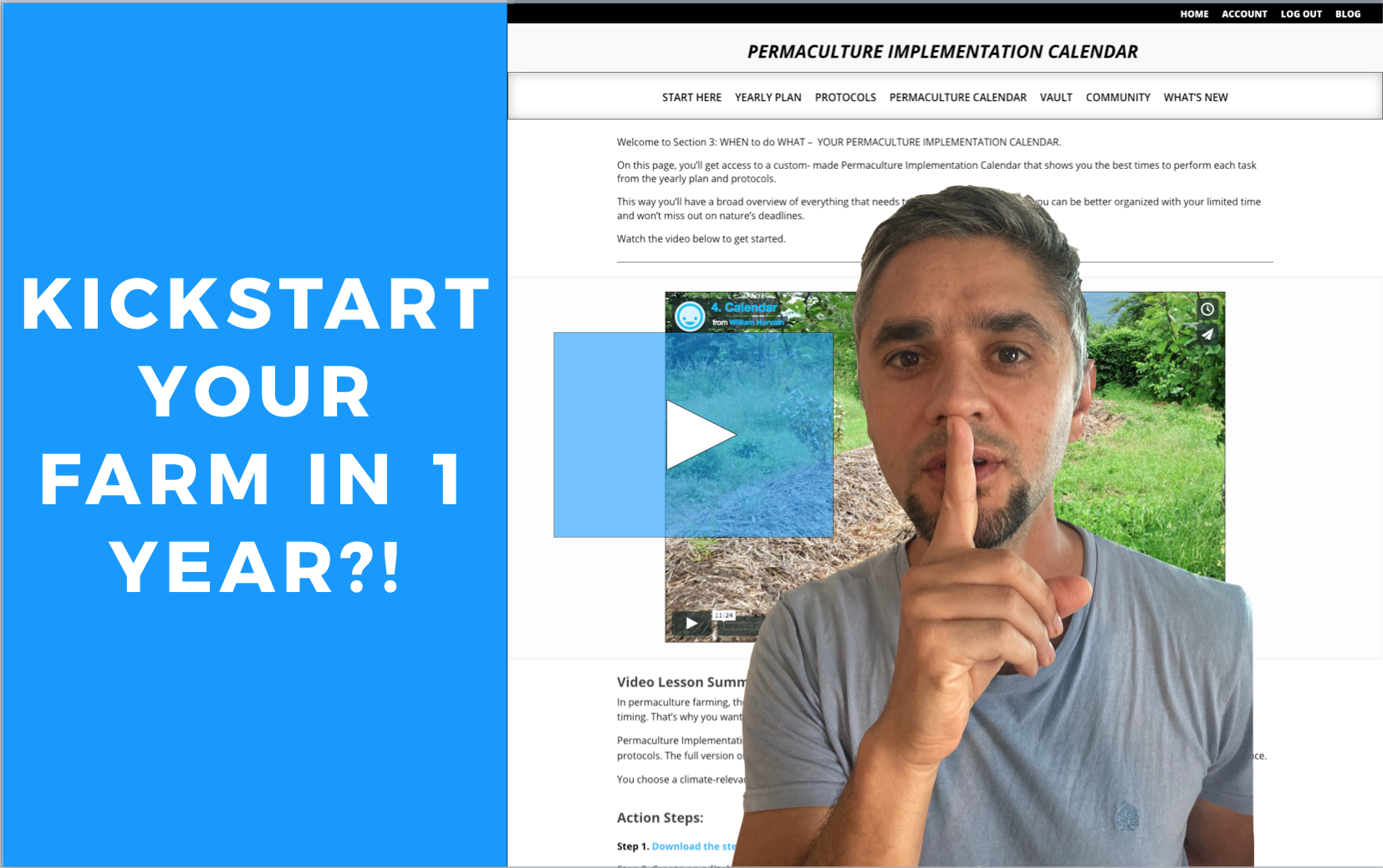Enrollment closes in…
Day(s)
:
Hour(s)
:
Minute(s)
:
Second(s)
PERMACULTURE IMPLEMENTATION CALENDAR
KICKSTART YOUR FARM THE RIGHT WAY AND PRODUCE ORGANIC-EVERYTHING FROM THE GET-GO, WITHOUT COSTLY MISTAKES THAT SET YOU BACK YEARS…
… BECAUSE LIFE IS TOO SHORT NOT TO ENJOY YOUR FARM AND EVEN SHORTER IF YOU’RE FORCED TO EAT SUPERMARKET FOOD!
Let’s be honest, everyone has big permaculture plans when the season starts.
I’ll sort out the gardens, orchards, compost piles, earthworks, renovate that garage, build that greenhouse…
And you enthusiastically start all these different projects, all at the same time, stretching yourself thin, overworking and putting extreme pressure on yourself and your relationships.
Then, eventually, despite your best efforts, enthusiasm and goodwill things just don’t go as planned.
At some point, you start falling behind, overwhelmed by everything you still need to do, until you are forced to throw in the towel, saying: “well, that’ll just have to wait until next year!”
I know, in an ideal world, we would already have our fully-functioning permaculture farm or homestead.
…swales hydrating the landscape, food forests producing an abundance of fruits and nuts, soil teeming with life, gardens full of produce…
And the quicker we can get to that, the quicker we can enjoy the abundance, the freedom, the security, and the peace of mind. The math there is fairly simple…
But practically getting there, that’s a bit complicated because of that inconvenience known as life.
THE REALITY OF LIFE
We all love farming, being outdoors and the agrarian lifestyle, it’s our calling. Ultimately, the dream is to have beyond-organically grown everything, long-term energy/food/financial independence and a farm that makes others go green (as it were) with envy …
The biggest challenge in achieving that is not necessarily having the money, but actually living a life: having a family, an off-farm job that pays bills, a social life… and then finding enough time left over to do anything substantial on the farm.
There’s simply not enough hours in the day, days in a week, weeks in a month to do everything that needs to be done in order to establish that permaculture farm or homestead in the timeline you were originally hoping for.
If you could only quit everything else and just devote your full time to the farm, obviously that would be the optimal solution, but then how would you pay the mortgage, still have your marriage and the kids around you, keep your social network…
The reality for most of us is that we’re developing our farms on our own, with our limited time and budget. The resources and manpower are always going to be scarce.
So how can you have a life and despite everything still achieve your big farming goals?
The answer lies in breaking the work up into manageable chunks, prioritizing, knowing WHAT to execute and WHEN, sticking to a pre-planned schedule, and being effective at what you do!
That’s the only way to realistically achieve what you want with what you have and speed up your farm development.
Because if you prioritise the wrong projects and miss out on important planting/management/maintenance/establishment deadlines, you fall behind and then have to wait for the next year!
Realistically, making progress with your farm development in today’s world is more crucial than ever before….
HERE IS WHY YOU NEED TO SPEED UP YOUR FARM DEVELOPMENT
I personally feel that there isn’t that much time left for living the life we’re all used to today. It’s a gut feeling but one that’s backed up with a ton of research.
If you’re reading this you probably have that feeling as well. You can see that there are a lot of things wrong with our society and consequently there will be some major changes headed our way.
I think we can all agree they are coming sooner rather than later, and today there are many concerning developments that all point to a future that will look drastically different:
CLIMATE CHANGE CATASTROPHE

Unless we make dramatic changes, we’re most certainly headed for catastrophe.
If current trends continue, by 2040, the recent IPCC report predicts there could be global food shortages, the inundation of coastal cities and a refugee crisis that will make the current one look small-scale in comparison.
That means you might no longer find everyday staple crops when you go into the supermarket… You might have to stay with your in-laws (or even live on the streets!) for months because you can’t find any place to rent due to overdemand… And during all this you’ll be on your own as nobody from the government’s social services will be picking their phone to help you out.
Avoiding that scale of suffering requires such a thorough transformation of the world’s economy, agriculture, and culture in a way that “there is no documented historical precedent.”
According to the UN, we have only 10 years to act, or else…
GEOPOLITICAL INSTABILITY

Western liberal democracy and neoliberal capitalism have spectacularly failed to make the world a better place.
Instead of the peace, harmony, and prosperity that we were all hoping for, what we see today are increasing international tensions between countries and domestically between the people themselves.
The great American empire is falling, crumbling before our eyes, descending into cultural/ideological/political war that has historically always been a clear sign of the last stages of a falling empire. All while China, as a new superpower with a questionable agenda, rises to challenge the old and drunk Uncle Sam.
This battle of civilizations can last for decades, taking down many collateral casualties with it, mostly in terms of livelihoods of ordinary hardworking people who just want to live their lives normally.
Imagine a future where you might get lynched on the street because of your political affiliations, lose your business because of a trade war, or left without electricity for days because of a cyber attack…
The things have only started to escalate and have a long way to go still..
THE GROWING POLICE STATE

If this pandemic has shown anything to the world’s elites in power, it’s that people will willingly sacrifice their freedoms for safety. Actually, because of the fear instilled into them by mainstream media, they’ll demand protection from the government, who then gladly puts more population control infrastructure in place.
The problem with all these “temporary” security measures is that they are here to stay, permanently. The government won’t voluntarily dismantle the surveillance infrastructure and laws that it finds useful in controlling the populace. There’ll always be dangerous contagious viruses out there, as well as other threats, such as civil disobedience, for example.
So everything we readily accept in the name of safety becomes the norm and just the way things are from now on.
As we descend further down this dystopian path, the question is: where does it end?
Soon the only place where you’ll be able to live freely, have the liberty to socialize with as many people as you want, and have any degree of privacy might be your farm or homestead. Far away from any CCTV’s, oppressing public servants, and people who call you a conspiracy theorist for having an opinion that goes against the mainstream.
THE NEXT GREAT DEPRESSION

Economists warn that due to the massive economic hit caused by the pandemic, we’ll soon face another worldwide financial crisis much greater than the already devastating Financial Crisis of 2008.
Before the pandemic, we were already at the tipping point. All the ingredients for another major recession were already there: interest rates near zero, sluggish economic growth, asset prices at all-time high bubble levels.
The COVID-19 was just the pin that popped the bubble and accelerated the economic crash. As it stands currently, it’s not a matter of whether the economy will crash or not, it’s only a matter of when and with what economic consequences it will have for us ordinary people.
Right now, we are at the economic equivalent of the time between earthquake and tsunami. The earthquake was the pandemic and the shutdown/lockdowns, and the tsunami is coming.
Soon, due to the astonishing amount of money printing by central banks worldwide, we could find ourselves in a situation where one month’s salary can’t buy five days’ groceries because of hyperinflation (as is now happening in Venezuela).
THE HUNGER GAMES SOCIETY

We live in dangerous times, where the top 0.1% hold the same amount of wealth as the bottom 90%.
This staggering inequality has never ended peacefully! The last time the world saw the same inequality was before WWII.
Just consider what’s happening today. People are out of jobs, businesses are out of business, so how will they pay their rents? There is a massive migration of people moving out of big cities, so how are cities to raise taxes when there are fewer people to tax?
The ordinary people and small to medium businesses struggle while the big businesses are getting the ‘printed money handouts’ and getting rescued. The real economy is suffering while the stock market is at all times high, and thus inequality grows.
This rising inequality and social polarization will lead to more social unrest, political extremism, and the militarization of the police.
When the time of ultimate distress arrives, the political elites and the top 1% will simply retreat to their gated compounds or their luxury fallout shelters and the rest of us will be left to fend for ourselves.
So we need to act quickly and prepare for some rough years as there isn’t much time to lose.
THE FARM IS YOUR INSURANCE…
I believe that your ability to weather the financial storm is in direct proportion to how many productive systems you have in place on your farm.
As Rob Avis would say the farm is your insurance, and acts as a hedge against whatever might be coming… especially in the age of economic and political upheaval, civil unrest, food supply disruptions, and mass unemployment.
To survive the next financial crisis, we need to become as self-sufficient as possible..ideally within a community of likeminded people.
This was always the case, and it will only be exacerbated in the coming age of pandemics. (Covid-19 was just the beginning – deforestation is still on the rise, increasing the human exposure to viruses and bacteria that can make cross-species jumps.)
We know this from our own lived-in experience in 2020:
Remember how supermarkets ran out of stuff when the pandemic hit?
If the lockdowns and border closures had continued unabated for a full year, two years, three… countries that are net-importers of food like Sweden, the UK, Italy, Germany, Portugal, Saudi Arabia, Japan would have starved.
This year the entire world had a very rude awakening: there will come a time in the near future when you won’t be able to BUY food – no matter how much money you have.
Of course we permaculturists are way ahead of the “worry-curve”. Most of us have been worried about the food security of our families for years or even decades.
That’s why we got into permaculture.
That’s why we want that ecologically resilient homestead, that self-sufficient permaculture farm, that abundant food forest…
Now is the time to stop dreaming the dream and have something materialise from it.
THE FARM-DESTROYING DANGERS OF DOING THINGS IN A HURRY
Now I understand, it’s completely natural that in the face of all these challenges, feeling pressured by the limited time, most of us want to get things sorted out as quickly as possible.
As the days of the growing season start to count down to zero, the race is on, and there are nature’s deadlines and planting windows when things ought to be done.
But with a million things on your plate, it’s far too easy to get side-tracked and then do things at the last moment without any real plan, recklessly, in the name of just doing something, anything.
This is a recipe for a disaster…
The chances are… by doing things in a hurry and not being prepared you’ve done a poor job that will entail further setbacks in the long run.
The worst thing is, it could take several years until you find out that things won’t pan out the way you initially imagined.
For example, suppose it’s September 30th.
You only have four weeks to plant bare-root trees, because, by November, the soil becomes too wet for planting. So you rush out and start digging some holes in the ground.
But in your hurry, you don’t realize that the holes were too deep, and once you planted your trees, you buried the tree’s graft union, completely overriding the desired rootstock effect of waterlogged soil resistance.
The problem is…
The week you planted your trees, everything is fine. The next week everything is fine. You don’t realize the mistake until a year later when you start to notice that your trees aren’t growing the way they should and start to look sickly and anemic.
You have thrown away your time, money and labor in vain and honestly, if you want to make a go at permaculture farming, you won’t get that many more chances. You have to make every year count.
Not just because you might be 60 and now you have only 10 more seasons left in life but also because, as I said above, the world economy, society, and environment may drastically change in the next year or so and then you’ll be forced to abandon your dream because there is no functioning farm to fall back on as your safety net.
So yes, we need to start getting things done but when you do something you want to do it right the first time, do it efficiently, build it to last and make sure that all the time, money and labor you’ve spent was worthwhile.
WHO AM I TO TELL YOU ABOUT FARMING AND LIFE IN GENERAL?
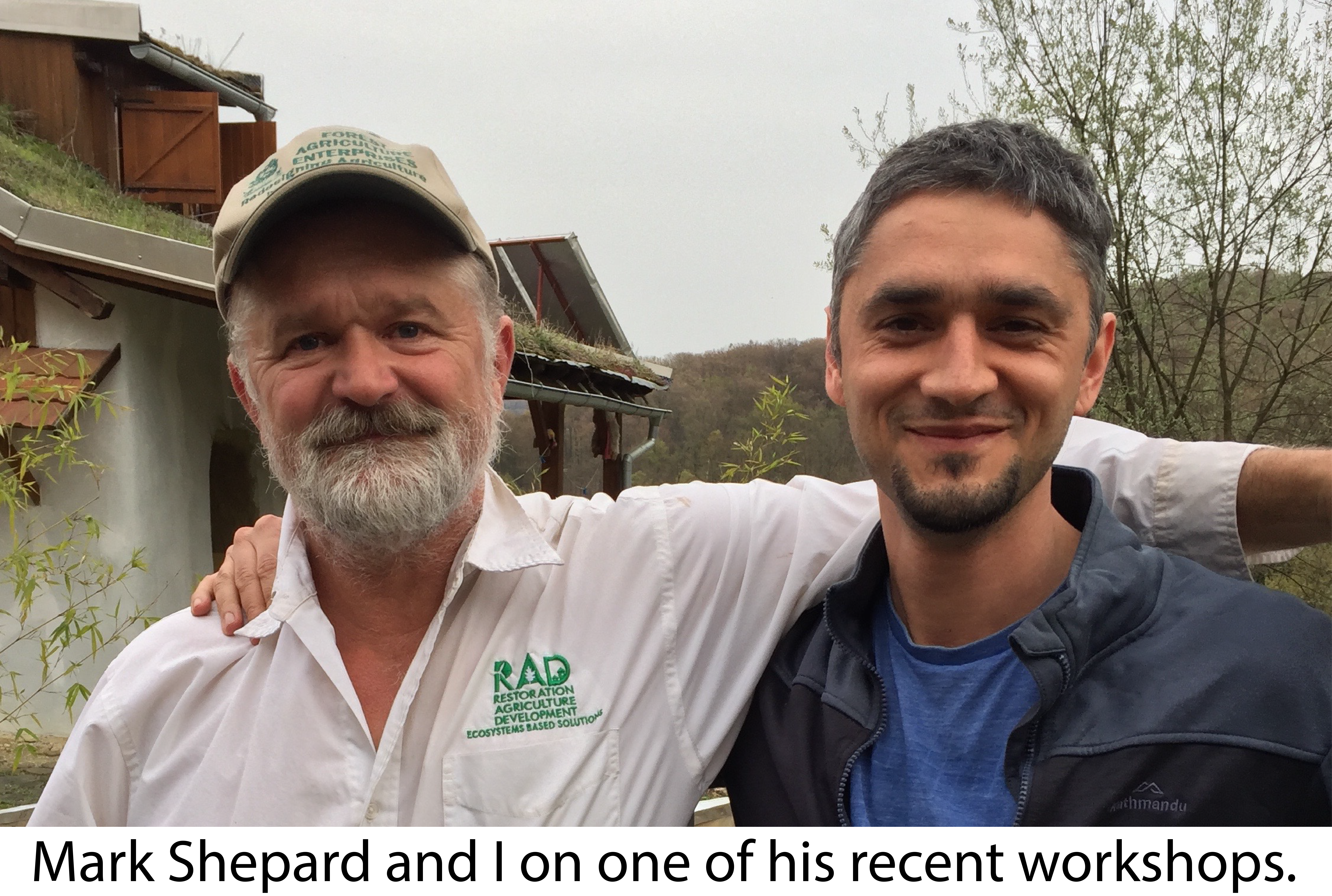
Hi, I’m William Horvath, a father, farmer, small-business owner, permaculture designer, blogger, creator of Permaculture Apprentice… I wear many hats and juggle many plates.
A big chunk of my time goes into creating content for my website and helping novice permaculture farmers. Over 160,000 people read the website every year (826,622 website visitors over these last 5 years), and more than 22,000 have signed up to our newsletter.
This has been very rewarding because in the last few years I’ve helped hundreds of people looking to start a permaculture farm and live a permaculture lifestyle, going from the absolute beginnings to implementing the first important practical steps in the establishment of their dream lifestyle.
But when I’m not working as a teacher/consultant/content creator I still have a farm to run with many different farming projects, moving pieces and obligations. Oh, and did I mention other life responsibilities such as family to take care of, and to my mind, this always comes first…
The demand on my time is incredible and naturally, when juggling so many things, it’s easy to get overwhelmed and then fall behind on various farm projects, miss out on seasonal deadlines and then have to wait for the next year. This has always been a source of frustration in my farming life and the “brakes” slowing my progress.
So I’ve been forced to constantly think about time-management, efficiency and how to achieve the best results for the least effort.
When you’re a solo farmer like me, it’s almost impossible to shut out distractions and start executing in the midst of competing interests which are also important (family, fixing up the house, job to pay off a mortgage etc).
Like most people, I remember finding the “implementation” phase the most challenging, especially on raw land.
There was so much to achieve once I got to this stage of the design process (five years ago) that I struggled with deciding what should be done first. Soil improvements for example take time to become fully active, so I wanted to do that early on yet water and structures are normally done first.
The PDC teaches you a lot about layout and soil care, but what I feel it doesn’t teach you much about, is what to prioritize during development, what to invest in in the first few years, and details of growing either orchards, pasture, annuals, and vegetable gardens.
Details can make a huge economic difference in your first years, and I would have really appreciated reading about other farmers’ mistakes and growing advice…
The biggest things I needed help with were timeframes or expectations around the development of a functional permaculture farm.
As a solo farmer, a father, a husband… I realised early on that I needed a system to keep me on task if I was going to get ANYTHING done on the farm..
I realized that if I had a yearly plan and a month-by-month list of permaculture farming tasks in front of me, with quick-start guides at my fingertips, my life would be so much easier.
For instance, I would be able to plan in advance, do things on time, in a proper way, and not have to lose sleep over encroaching deadlines. (I’d even know in advance when I can plan to take a few days away and not miss an important harvest!)
So this led me to researching, extracting, and compiling a range of bits and pieces of theory and practice about permaculture implementation and how and when it should be done. And the end result is now something tangible, concrete and always relevant that I’ll be using year after year so that I can make the best use of my precious and limited time, money and energy!
Thus eventually speeding up the development of my farm and producing that abundance sooner rather than later…
There are a lot of voices in Permacultre and sustainable agriculture these days, but I’ve never found one more reliable, insightful and useful as William Horvath and Permaculture Apprentice. The way that he connects the dots from a wide variety of progressive practices such as holistic grazing, food forestry, keyline earthworks and many more, can only come from someone who has put them into practice through experimentation and constant observation.
When I first opened PermacultureApprentice.com, I was blown away that I hadn’t discovered it earlier! William’s ability to distill the teachings and experimentation of the permaculture greats has allowed a new generation of regenerative farmers and designers to take permaculture to the next level. Working with William is a joy, because he brings a lighthearted curiosity to his core focus: helping you succeed.”
INTRODUCING THE PERMACULTURE IMPLEMENTATION CALENDAR
THE WORLD’S FIRST MONTH-BY-MONTH PRACTICAL PERMACULTURE CALENDAR, GUIDE AND IMPLEMENTATION SYSTEM
If you’re a permaculture farmer who is starting out with your farm development and long for practical guidance on implementation and a monthly calendar so you know exactly WHAT to do and WHEN, then you’re in the right place.
This is a system for farm owners who want to kickstart their farm development and achieve food security twice as fast and with less effort, without killing themselves from overwork, neglecting their family and always falling behind the schedule.
Because everyone wants a fully functioning permaculture farm yesterday, yet nobody wants to work themselves to death to get there.
With this system, you won’t be always late, falling behind, and doing a poor job of implementing things… eventually being forced to wait for the next year, and the next year, and the year after that…
Nobody likes setbacks, so why not implement your permaculture projects this year, the way they should be from the outset, and move faster to your ultimate goal of a permaculture abundance for you and your family?
Make this the year you stop dreaming the dream and something finally materialise from it!
PROGRAM STRUCTURE:

The program has 3 main components:
- #1) YEARLY PLAN which outlines WHAT to do this year (and in which order) to kickstart your farm and ramp up your food production
- #2) PERMACULTURE IMPLEMENTATION CALENDAR which tells you exactly WHEN to do the WHAT, so that you never miss nature’s deadlines and can get the greatest yields for the inputs you invest by working with natural cycles (rather than flailing against them!)
- #3) IMPLEMENTATION PROTOCOLS AND GUIDES which explain HOW to do the WHAT. Written, printable, step-by-step instructions/spreadsheets/checklists for each of the tasks on the calendar. These are packaged as “quick-start” and “get ready” guides so that you can do things right the first time, without being overwhelmed by information.
… plus! You get a bonus FARMER’S VAULT with an ever-growing database of useful farm setup resources.
Once you join you’ll receive immediate access to all of the programme materials. Then, no matter what time of the year it is you can start planning, using the calendar and its instructions and start implementing the practical steps that will put you on the road to the farm you’ve always dreamed of having.
Unlike other permaculture courses, the Permaculture Implementation Calendar always stays relevant. It’s not one of those one-off, “use it now or lose it” things. As the seasons keep changing you’ll be always planning the current and next year, implementing, maintaining, making optimal use of the available resources…
To the best of my knowledge, there is nothing similar to this anywhere to be found on this planet, online or offline…
Here’s exactly how the PIC system works:
Click the video above to take a guided “VIP Tour” of Permaculture Implementation Calendar
Transcript | Slides
COMPONENT #1: YOUR YEARLY PLAN
– SAY GOODBYE TO ANALYSIS PARALYSIS, AND INSTANTLY KNOW WHAT TO PRIORITIZE WHEN DEVELOPING YOUR FARM –
“I need a strong plan with phases.”
We mapped out the exact yearly plan you should follow this year to kickstart your farm this year and ramp up your production every growing season thereafter.

Think of this as the game plan that shows you what route to take, what you need to prioritize, what projects to tackle first, and what to leave out.
“How do I prioritise? I’m afraid of spending my time and money on things that aren’t that important, and wearing myself (and any help I get from friends and family) out. I want to make sure that what I do spend time (and money) on is worthwhile.”
If you are stuck in analysis paralysis, this yearly plan can help you avoid common mistakes and prioritise projects that really bring in the yields.
For example, if you’ve just completed your PDC training this year and now the challenge is “What next? Which projects should I now start with?”, this plan is going to be the panacea to that headache.
Ever said to yourself “I need a strong plan with phases”? This is that plan.
The yearly plan is split into two categories, one for growing a food forest and one for growing annual gardens. And it showcases the stages or overall steps you need to take in establishing these systems, gives you the breakdown of tasks you could do in each stage, and pinpoints the timing for these stages and tasks.
Since we all deal with different variables, the plan will always be context-specific. That’s why I created a flowchart to help you decide where to actually start and what exactly to do.

The flowchart recommends a specific implementation protocol for each scenario you are faced with on the farm.
Speaking of protocols…
COMPONENT #2: YOUR FARM PROTOCOLS AND IMPLEMENTATION GUIDES
— EXECUTE PERMACULTURE PROJECTS CORRECTLY (EVEN IF YOU HAVE LITTLE TO NO FARMING OR GARDENING EXPERIENCE)—
“I need implementation instructions that are as simple as possible, and can get me from zero to functioning farm without fancy equipment costing thousands of dollars”
One of the challenges of Permaculture is that it straddles so many different disciplines, from biology, ecology, landscape design, agriculture, geology, to hydrology and others…and consequently there are extremely numerous & diverse skills required to launch a permaculture farm or homestead.
Nobody has time to learn everything they would like, or find interesting, or even find important, as that takes significant googling hours, studying permaculture literature and then trialing it in practice.
So when you start a new permaculture project, you often feel out of your depth and overwhelmed with everything the project entails.
The solution to this is to get a recipe for how to do something right, do it, and learn through that experience. This helps you avoid all the googling, studying, and eventually reinventing the wheel. You just study the task at hand instead of trying to learn everything just in case you need it one day.
In this section, you get these recipes, so to speak, that can help you overcome the lack of time, experience, and confidence. I’ll give you step-by-step guides on how to implement, so you have a guide to follow for each project and are able to execute the right steps the first time around.
Now let’s give you a whistle-stop-tour of what you’ll find in this section:
A) PROTOCOLS
First, we have Protocols. Think of these as “workflows” or standard operating procedures so that you know what to expect and the most efficient way to tackle a project.
… because why waste your resources on reinventing the wheel when you can learn the best practices and prepare in advance?
Another way to think of these protocols is as a blueprint for achieving a specific goal.
For example, let’s say you want to establish a food forest, and you are starting from scratch on raw land, and your plot is on a slope with eroding soil where runoff is an issue so you need to install swales to catch the rain. That’s your goal. And the blueprint (protocol) to achieve that goal would be: Food Forest with Swales Establishment Protocol.
Protocols for which projects exactly?
In this edition of the PIC it’s all about growing food, so examples of protocols include yearly food forest maintenance, starting a garden from scratch, establishing a food forest with swales from scratch.
You get access to 7 different protocols, 2 about establishing an annual garden, and 5 about establishing a food forest:
- New garden protocol
- Existing garden protocol
- Food forest with swales establishment protocol (spring planting)
- Food forest with swales establishment protocol (fall planting)
- Food forest w/o swales establishment protocol (spring planting)
- Food forest w/o swales establishment protocol (fall planting)
- Food forest maintenance protocol
Notice that I give you protocols on not just how to establish food forests and annual gardens, but also to how to maintain them so that you can ramp up production year after year.
These maintenance protocols allow you to identify maintenance tasks and monitor your farm system so that you’re always on top of everything and in due time.
…because if you can’t properly maintain what you started the passion turns into drudgery and ultimately becomes a burden… Plus, you know, the garden just dies. 😅
How each protocol is structured:
Each protocol maps out a set of specific tasks you need to do and the order in which you need to do them.

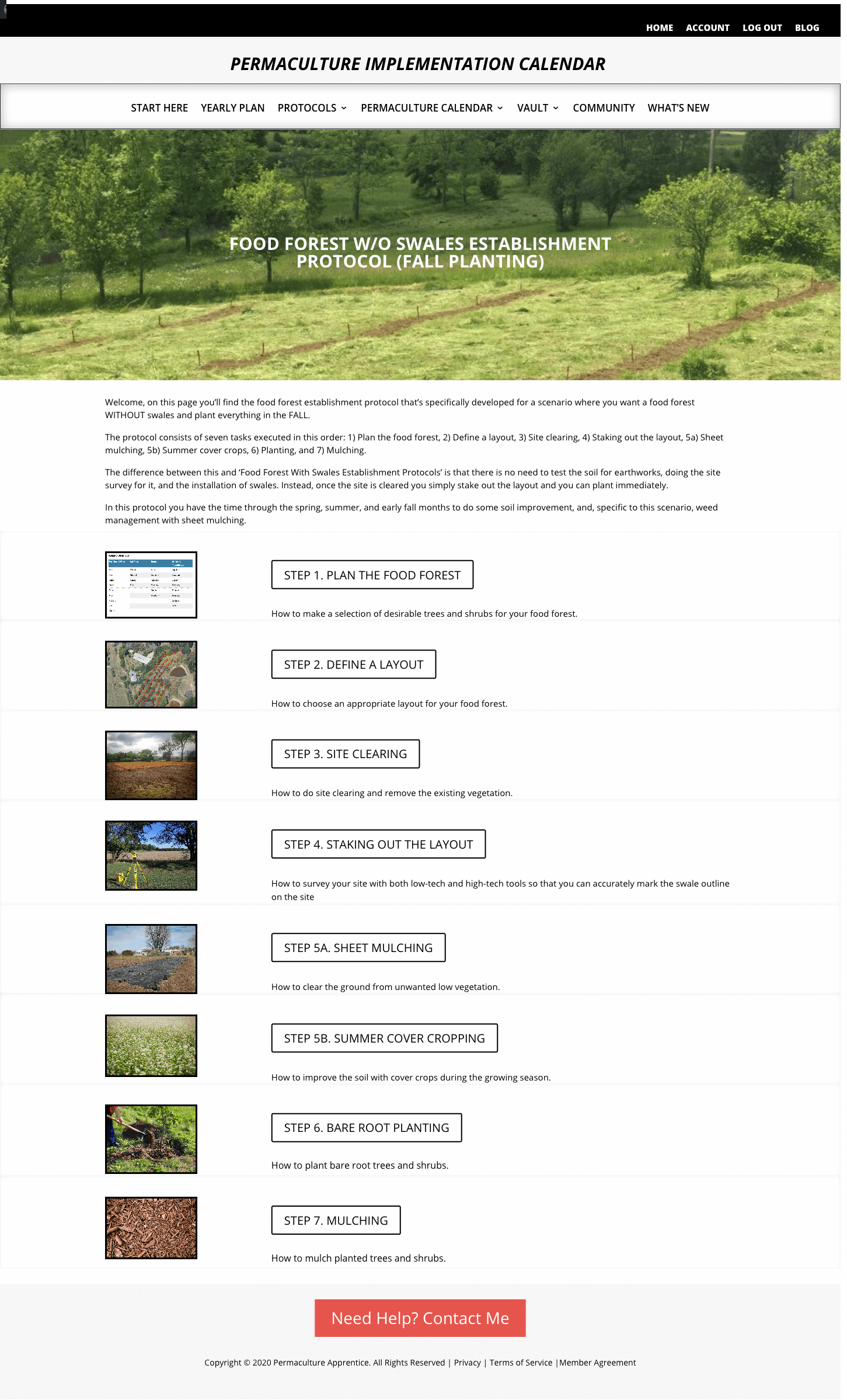
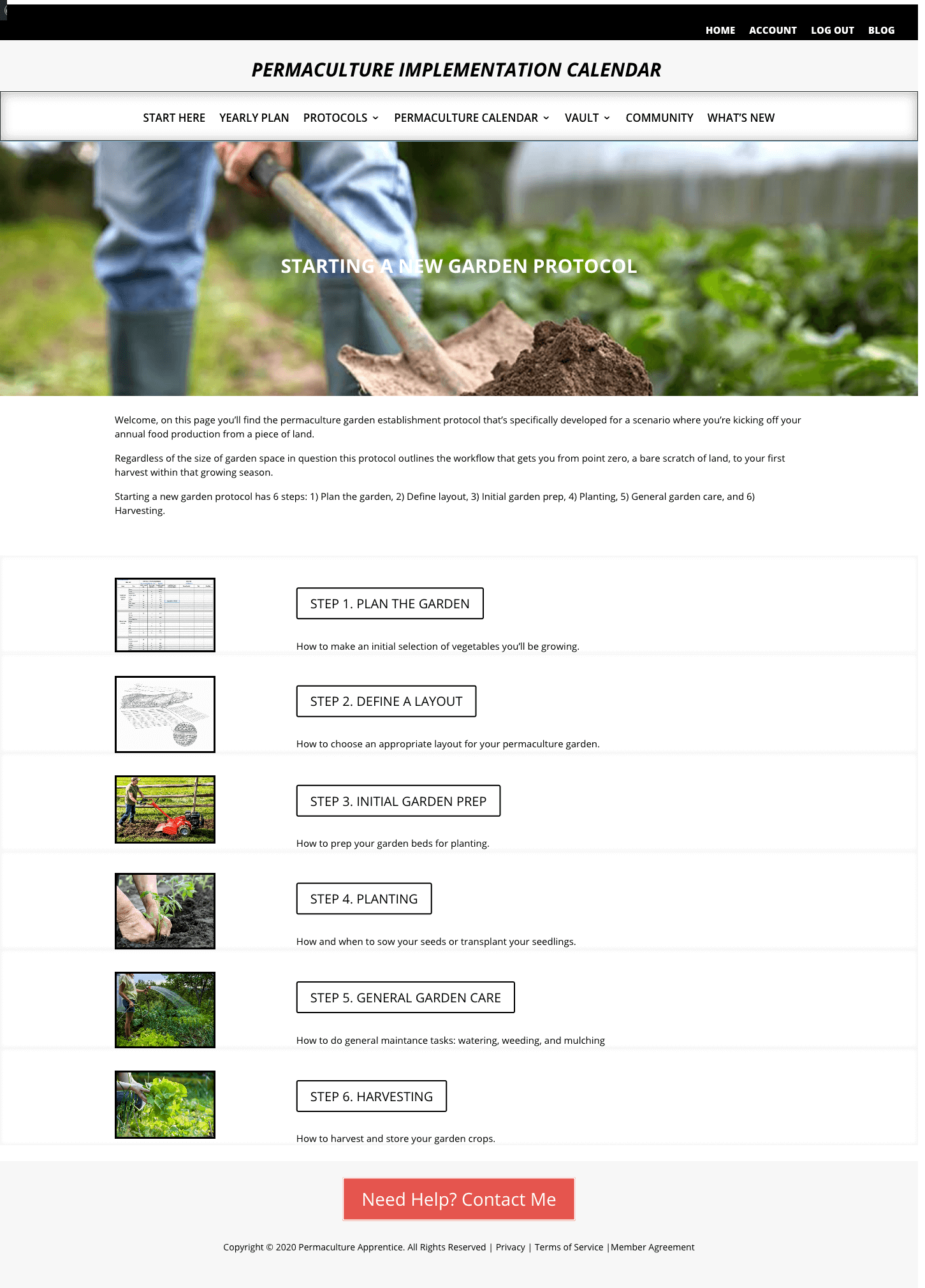
B) IMPLEMENTATION GUIDES
Second, we have Implementation Guides. Think of these as step-by-step instructions for a specific task. They outline the exact practical things you’ll need to do with your hands and give you clear instructions for it.
You can print out these guides as paper documents or access them on your tablet or smartphone and use them as your reference, on- and offsite, both prior to starting and when doing the actual work.



Guides for which tasks exactly?
This edition of the PIC comes with 26 implementation guides covering all the tasks necessary to establish your gardens and food forests:
- Install Swales
- Summer Cover cropping
- Bare root planting
- Test the soil
- Survey the site
- Apply compost tea
- Measure tree growth
- Add soil amendments and fertilizers
- Foliar Feeding
- Mulching
- Spread Fungal Compost
- Staking out the layout
- Site Clearing
- Plan the food forest
- Food Forest with swales layout
- Food Forest w/o swales layout
- Initial Garden Prep
- Fall/Winter Garden Prep
- General garden care
- Harvesting
- Planting
- Sow Green Manure Crops
- Plan the garden
- Garden prep
- Garden design
- Sheet mulching
In addition to that you’ll get access to Implementation Guides Library with ALL the implementation guides that I have created thus far, which expand implementation advice beyond the primary focus of this edition of the PIC.
How the implementation guides are structured:
The guides have introductory information explaining what the task is all about, giving you a better understanding about the task at hand.

They give you a checklist of what you’ll need for the task, the list of equipment/tools, and materials. And if applicable give you a direct link where to source things from the list.

I’ve also included, where I had some data, an estimated time required to perform the task so you have some sort of an idea about the time commitment.
Then you get the step-by-step how-to, no fluff, just straight-up practical instructions on what exactly to do with your hand and tools.
This is condensed information sourced from multiple books, websites, podcasts, personal experience all boiled down to the most important bits of information.
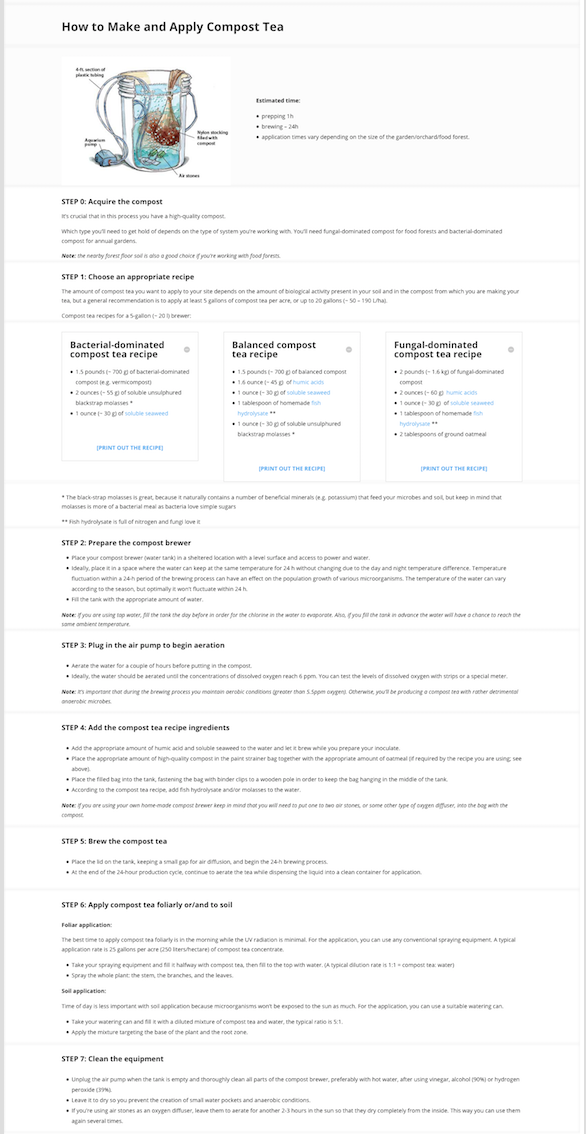
Some guides will also have additional spreadsheets to help you with the planning and logistics of the tasks so in some cases there will be more to the guide than you see on the page.
These spreadsheets are easily integrated with your yearly plan, flowchart, and calendar, so that you can have a sort of a farm management dashboard where you have everything you manage in one spot.
I’ve also included additional resources such as videos, relevant books, articles, PDF’s you can dig into to further your knowledge about the task at hand.

No fancy equipment necessary!
Now, the best thing about these guides is that they show you the easiest way to do a task.
Although I do outline how to do things in different ways based on the tools/equipment you might have, you don’t need any fancy equipment to implement what I’m teaching you here. I’ll always include the simplest way on how to implement something.
And if you at any time have any questions or need help with any of the steps or the implementation of the whole task, there is a discussion forum under each of these guides where you can leave your comment for me.
COMPONENT #3: YOUR MONTH-BY-MONTH PERMACULTURE CALENDAR
— ALWAYS BE PREPARED IN ADVANCE AND NEVER MISS OUT ON THE IMPORTANT PLANTING/MANAGEMENT/MAINTENANCE/ESTABLISHMENT TIMES OF THE YEAR—
“I need a calendar of events and reminders for what needs to happen to help with all the confusion that is constantly in my head…”
Compared to normal people we permaculture farmers tend to think differently about changing seasons.
Where ordinary people see yellow fallen leaves on the ground simply as a sign of fall coming, we on the other hand are reminded of a narrow window when certain farming tasks ought to be done.
The mind starts buzzing with thousands of thoughts, ideas, and to-do’s about getting plants, sowing seeds, planting, harvesting, improving the soil for the next season, preparing for winter…
With so many competing things to do it’s far too easy to lose track of what you should be doing, when, and how. The chaos slowly creeps in and it starts to be a complete mess in the head.
Now imagine a different scenario…
You still have your thousands of thoughts, ideas, and to-do’s… BUT now you have a pre-planned schedule, a calendar for when each of the important farming tasks that you are focusing on should be performed.
No matter how many competing tasks you might have, they would be anchored to specific weeks and months and you wouldn’t get overwhelmed so easily and miss out on any important deadlines.
You simply follow the calendar for your climate zone and you know what to expect, when to start preparing, and what to focus your attention on and at what time.
This month-by-month permaculture calendar forms the backbone of the programme. It comes in the form of an online and offline spreadsheet and printable PDF document where each of the important yearly permaculture tasks is mapped to the corresponding month.

Temperate climate calendar (Mediterranean, Subtropical, and Boreal Climate Zones also available. Both hemispheres included).
Looking at the calendar you’ll know months in advance what to prepare for, when to start planning, when exactly a specific task should be done, the deadlines and windows you shouldn’t miss, which tasks are recurring, and much more. All of the tasks are categorized, labeled with colors, and will be hyperlinked to the corresponding set of instructions/protocols/guides.
You can also make your personalised copy of the calendar, and then add/remove/move tasks as you wish…
How does the calendar integrate with the yearly plan and implementation guides?
First, I give you a simplified calendar that maps out the best months to do each project from your yearly plan for your climate zone.
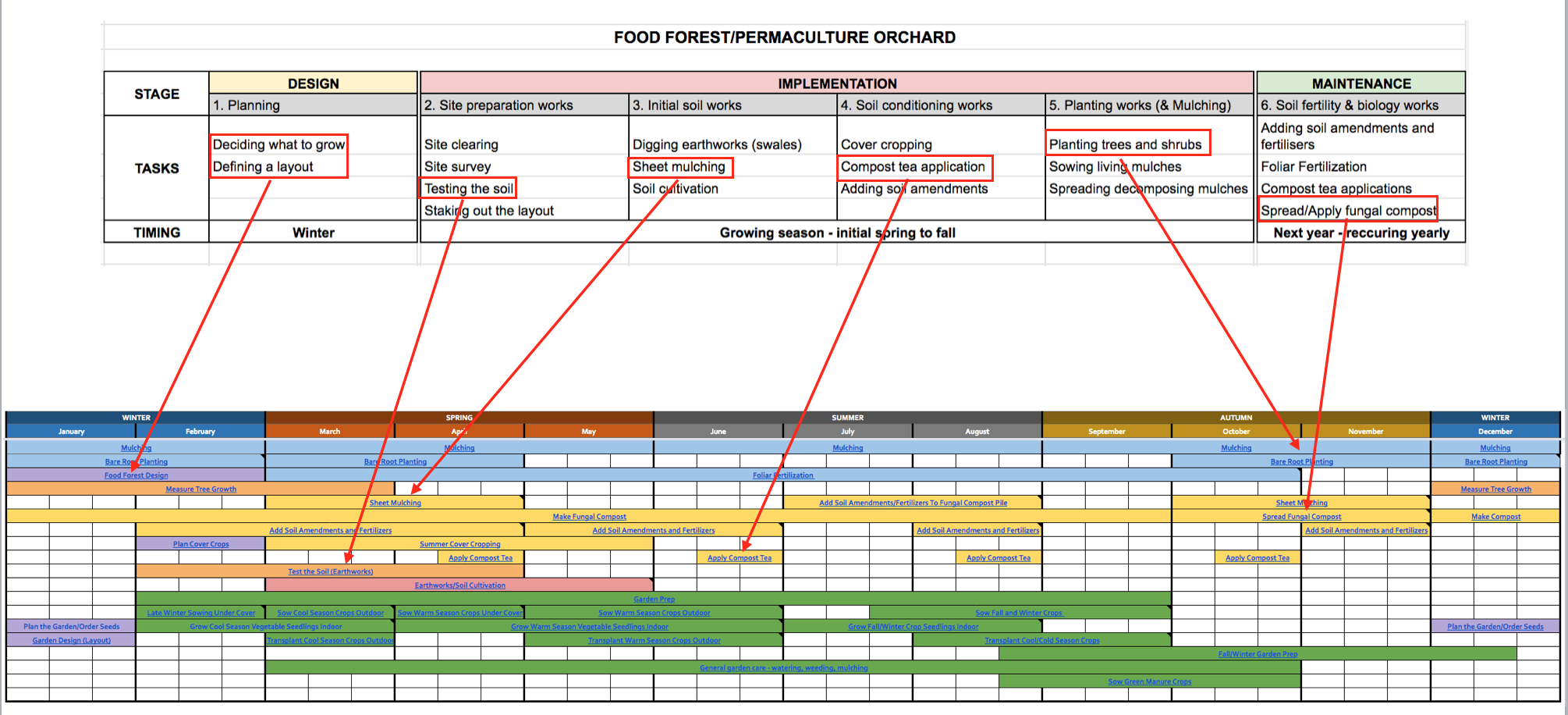
Each of the tasks on this “Jumpstart Calendar” is interlinked with appropriate implementation guides. So once you click on any of the tasks, it takes you to the webpage with the step-by-step instructions.
This calendar feature enables you to do things on your farm much faster and work simply and effectively without being overwhelmed by information.
Second, I also give you an “advanced” permaculture implementation calendar, which has more than 120 tasks mapped out across the whole year.
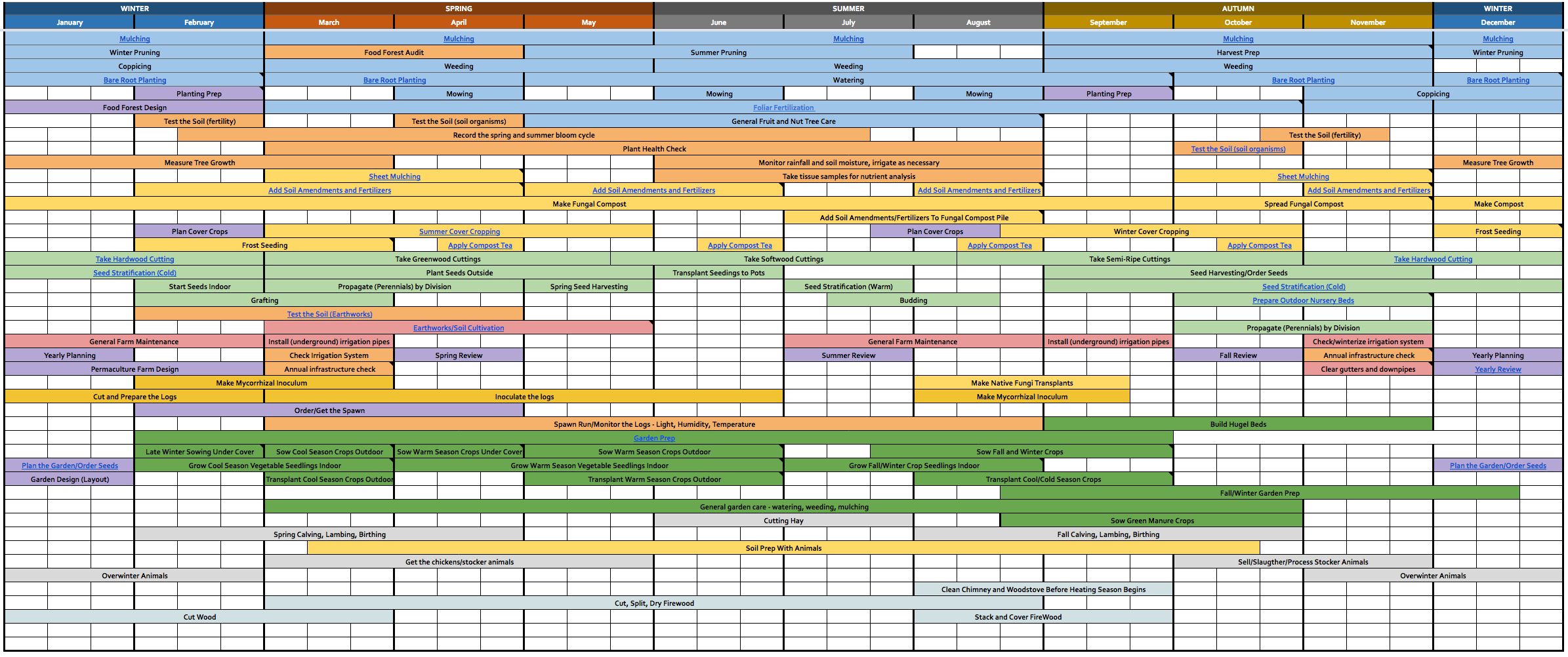
This functions as a “forever calendar” you will always come back to.
“Great, I finished Project X from the Yearly Plan early and I have two weeks free before Project Y starts. What should I do next? What other tasks are optimal for this time of the year?”
Third, you can also make your personalised copy of the calendar, and then add/remove/move tasks as you wish. This master sheet could therefore act as a central platform for planning your projects, noting down your observations and monitoring your farm.
Note that you can use the calendar on your computer, smartphone or tablet and access it from anywhere, whenever you need it. Whether you’re in your office and you want to do some monthly planning, you’re on the site digging holes and you need instructions on planting, or you’re in the forest and need to know how to collect mycorrhizal mushroom spores, you’ll never feel lost and unsure of your next stage again!
BONUS: Permaculture Farmer’s Vault
— The farm setup resource center; your unfair advantage —
The farm setup resource center is the PIC logistics center. In there, you’ll find numerous resources to help you with the logistics of executing your projects, from farm setup working documents, worksheets that expand calendar functionality, lists of contacts and suppliers, various other databases…
I just finished creating a networking database of people who’ve opted into a private directory to find and be found by others. Here you can browse the directory and perhaps discover a like-minded permaculturist who is in your neighborhood, town, city, or region.
As I keep improving the programme, I’ll be adding new features and unique bonuses here!

HOW TO USE THIS SYSTEM
The learning flow of this program is to first go through a yearly plan lesson, then plug and play protocols and finally a yearly calendar.
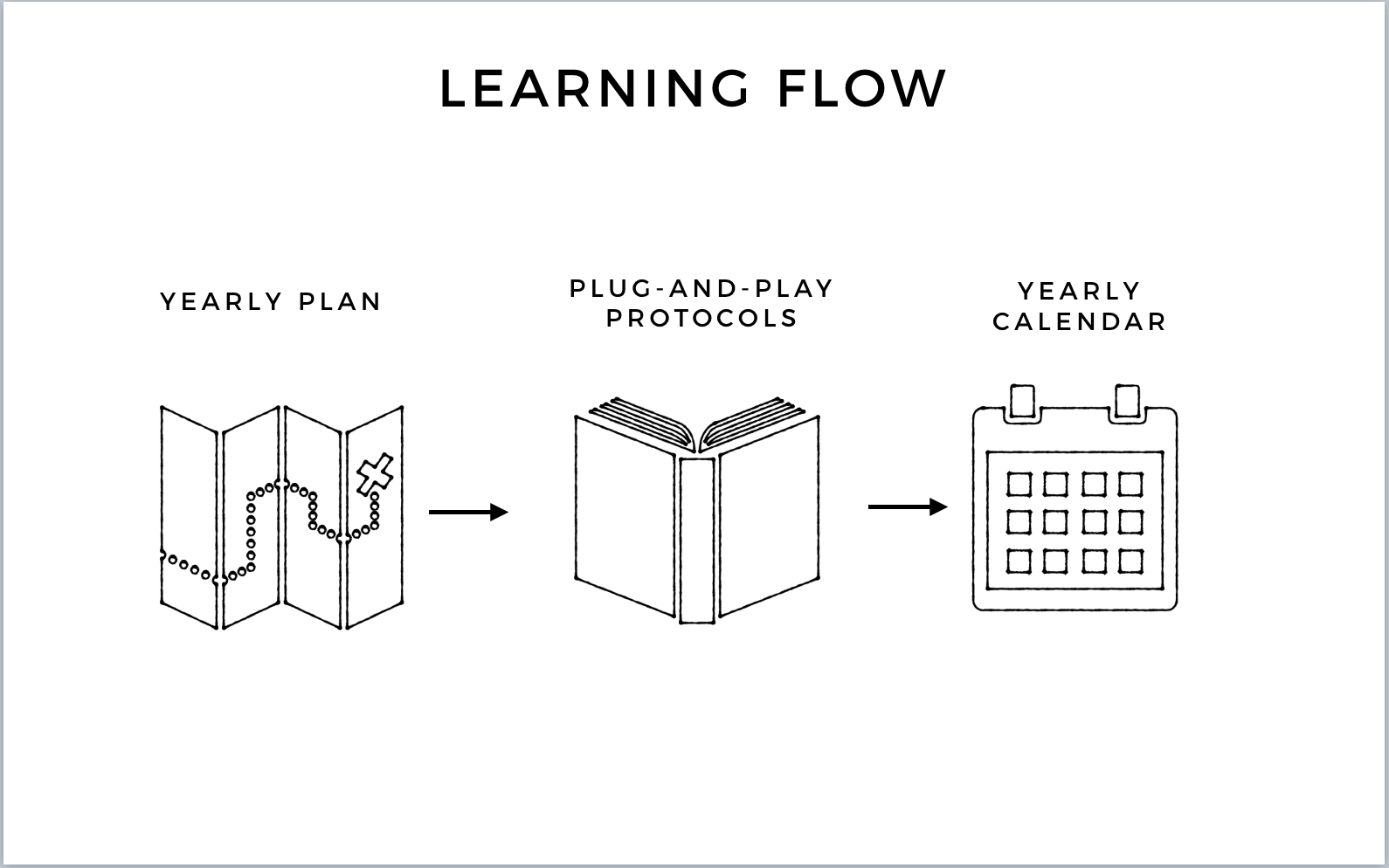
First you focus your attention on the YEARLY PLAN. This will be your starting point as you’ll get a roadmap of what you’ll have to do over the next 12 months to kickstart your farm’s food production.
Once you have an overview of what this will entail, and what projects you’ll need to focus on and prioritize, you then move to the PLUG-AND-PLAY PROTOCOLS.
You’ll work out the details of your implementation plan according to your context, select the protocols for the specific objectives you want to achieve (such as establishing a new garden, establishing a permaculture orchard from scratch or food forest maintenance) and you’ll get access to step-by-step instructions.
Then you move to the PERMACULTURE IMPLEMENTATION CALENDAR. Here you’ll create your own editable copy that you’ll use during the implementation process. You’ll be referring to it on a day-to-day basis and it will be your guide in timing your projects for your climate zone.
With the implementation calendar completed and ready to use, you are all set to get your hands dirty. You can now start implementing on-site…
…because life is too short not to enjoy your dream farm and even shorter if you’re forced to eat supermarket food…
JOIN THE COURSE TODAY FOR ONLY $USD197 (or 5 instalments of $47)
Yearly Plan
The exact gameplan to follow this year and every growing season thereafter to kickstart your farm and start producing an abundance of organic-everything.
Protocols and Implementation Guides
Step-by-step instructions, planning spreadsheets and checklists for each project.
Permaculture Calendar
Month-by-month permaculture calendar that shows the optimal start and end times of each project for your climate zone.
Farmer's Vault:
An ever-growing database of useful farm setup resources and directories.
$USD197
one – time payment (save $38)
$USD47
5 monthly installments
HOW YOUR LIFE IS ABOUT TO CHANGE – HERE’S MY PROMISE TO YOU…
Want to kickstart your farm and achieve food security… yesterday?
Want to get an idea of how many years it would take to get the farm working (which right now is probably completely in the blue)?
Want to know exactly WHAT to implement WHEN and HOW so you don’t waste your money and more importantly time on projects that won’t produce the yields you need?
Then YOU are in the right place, and the Permaculture Implementation Calendar system is the answer to all your prayers… Read on…
With this system you will be able to:
- Prioritize and plan your yearly farm year efficiently and realistically, so that the right things get done on time
- Know exactly WHAT to do (and HOW) when implementing your design and setting up your farm, so you never waste your limited time and actually have visible results to show for your efforts
- Identify WHEN is the best time do each permaculture project, so you can work with nature to speed up your development, rather than struggle against it
And you’ll avoid:
- Doing half-assed jobs just in the name of doing something
- Spreading yourself thin because you have too much on your plate
- Implementing things incorrectly, and having to ripping them out later
- Always being late and missing out on nature’s deadlines, having to wait for the next year, feeling defeated and ashamed that things are not going as fast as you would like…
Because now:
- You’ll be ready months in advance, reminded in due time and eagerly waiting to smash that project on the first try
- You’ll break the work down into manageable chunks and keep on task (instead of tackling several things at once and failing to complete any of them)
- You’ll execute everything on time, speed up your farm’s development, and finally feel satisfied with the progress you’re making
And you’ll be able to do all this WITHOUT:
- Hundreds of unpaid interns
- Fancy farm equipment costing tens of thousands of dollars
- Ideal farming conditions (climate, soils, water, terrain..)
This system will work for you EVEN IF:
- You have limited farming/gardening experience
- You feel overwhelmed with everything you need to do
- You and your partner are both currently working full time jobs away from home and only really have weekends to spare at this stage
Make this the year you stop dreaming the dream, and finally have something materialise from it!
frequently asked questions
Q. WHO IS THIS PROGRAMME DESIGNED FOR?
This programme is primarily aimed at permaculture farmers who are starting out with their farm development, mostly doing things on their own, and need practical guidance on implementation, and a monthly calendar to know exactly WHAT to do WHEN, and HOW, with a specific focus on growing food.
If you have big yearly goals for your farm, but it seems like you’re never quite able to reach them because you also have a life to live, family to take care of, a job to show up to… then this is made just for you!
Q. I DON’T HAVE A DESIGN FOR MY FARM, CAN I STILL TAKE THE PROGRAMME?
Of course you can, the PIC will help you to understand what to do, when and how but… I would wholeheartedly recommend that you create a design for your farm first.
Naturally, implementation comes after you have a working design for your farm. So if you still don’t have your master plan I would recommend that you take one of my other courses – Permaculture Farm Design or Creating Food Forests Guilds – so that you have a strong foundation for your farm development.
Q. DO I NEED A PDC BEFORE I CAN START USING THE PROGRAMME?
A. It definitely helps if you have a PDC under your belt, as you’ll have an understanding of permaculture principles, but even without these, you can still follow the system and start the implementation process the right way. The programme is designed to help you implement regardless of your theoretical knowledge level.
Q. WILL THIS SYSTEM WORK IN MY REGION/CLIMATE?
A. This system will work for you if you are in temperate zone climates: oceanic, continental, mediterranean, subtropical and boreal.
If you’re in tropics, arctic and drylands (arid climate), you could still use the yearly planning framework, protocols, implementation guides, working documents and the bonus vault, but the permaculture calendars wouldn’t be applicable to your climate. You would need to adapt the calendar tasks to your specific climate context..
Q. IS IT POSSIBLE TO ADD MY OWN TASKS TO THE CALENDAR?
A. Yes, it’s possible, you can make your own personalized copy of the calendar and then add, remove, move tasks as you wish. It’s a spreadsheet like any other!
Q. HOW MUCH LAND DO I NEED?
There is no specific land size consideration, you could be doing your permaculture projects on your small backyard, homestead or on a 100-acre farm.
In the course, I do focus on permaculture farming related tasks, so you would need to adjust your expectations accordingly and understand that in order to get full value from the course your land would need to be at least 1/2 acre or above.
Q. WHAT DO I NEED TO TAKE PART IN THIS PROGRAMME?
A. All you need is a computer and an Internet connection capable of streaming videos on your browser. To access all the course material: video lessons, calendar, working documents, and the bonus vault, you can use your computer, smartphone or tablet, whatever works best for you. You’ll be also able to print out the calendar and all the documents/worksheets/checklists.
Q. HOW MUCH TIME WILL I NEED TO STUDY?
A. The PIC is a self-paced course so you can take it as quickly or as slowly as you want to, it’s entirely up to you. On average you will need only around an hour for the first and last sections of the program – the yearly plan and the calendar. This is mostly plug-and-play and involves a short amount of computer work.
The main demand for your time will be in the PLUG-AND-PLAY PROTOCOLS section of the program, as this is when you start on-site implementation. How long this will take is very context-specific and it depends on what you’re starting with, the resources at hand, available time, and labor. So it’s entirely up to you!
Q. HOW LONG DO I HAVE ACCESS TO THIS MATERIAL?
A. You’ll receive lifetime access to the material, so there are no time limits or deadlines to make the use of it. You can take the course in your own timing, at your own pace. Note that the course is usually sold 2x times a year, and only during these times you can enroll.
Q. HOW IS THIS DIFFERENT THAN THE GUILDS OR FARM DESIGN COURSES?
My other programs deal with the design, this is an implementation program.
In the Permaculture Farm Design Course and Creating Food Forest Guilds, I teach you how to design your permaculture farm and food forest guilds. The Permaculture Implementation Calendar helps you implement that design and provides the practical how-to for that implementation.
If you don’t have your design locked in yet, I’ll be opening these courses for enrollment early next year.
Q. WHAT IF I GET STUCK OR DON'T UNDERSTAND SOMETHING, WILL YOU HELP ME?
Of course, you get priority access to me and can send me your questions via email and I’ll answer them within one working day. If something is not clear it’s my duty to help you understand it!
Q. WHAT IF THIS DOESN’T WORK FOR ME?
Then you can ask for a refund. You have 30 days to try the system and, if you’re not satisfied, I’ll give you a 100% refund. The only thing I will ask you is to let me know how I can make the programme better.
>>TESTIMONIALS<<
HERE’s WHAT OTHER PERMACULTURE EXPERTS HAD TO SAY ABOUT MY WORK
Williams content is a “go to” resource for anyone wanting to build freedom for themselves by establishing their own
If you need serious and thoughtful help on planning your homestead, look to William for the answers. Don’t mess around. Let him teach you and you’ll grow like you’ve never grown before.
HERE’s WHAT MY STUDENTS HAVE TO SAY ABOUT THE COURSES I MAKE
If you have never heard of me or any of my courses, then please read some of the success stories below.
All of these people were struggling with their designs and implementation, overwhelmed with the information. Some of them even had multiple PDCs, but my courses helped them to put everything into structured manageable steps and take action.
After taking two PDC’s that were amazing and life changing, I felt overwhelmed and intimidated with all of the information. While I understood most of the concepts, when it came down to actually applying them, I had no clue where or how to start.
William’s course breaks everything down in layman’s terms and gives a clear step by step process that will give you the confidence to take action.
I have done other courses in permaculture and have experienced information overload at times with no idea which foot to put before the other to get started with my own farm.
William’s course gave me a step by step action plan but above all in a logical uncomplicated language that I can follow and I don’t feel lost!
Your course is by far the BEST I mean the VERY BEST!! I have ever taken. I have taken 4 PDC courses and yours made much more sense to me. It was the glue that brought everything together. If I had not taken the other courses it would have been fine. Yours gave me everything that I was looking for in a way I can understand and work. You have uniquely combined ALL learning styles in one fast easy simple fully packed course.
Your course laid things out simply and in a manner that can be used in many zones and locals – a rare thing to find since they usually exclude our conditions.
Books and courses chat too much and don’t get to the point. I valued that in this course that my very limited time was not wasted.
William has put together a comprehensive course to start a permaculture farm from scratch. Many examples, videos, tools and worksheets come with the course that allowed me to hit the ground running.
His personal guidance and very fast turnaround time when answering emails are amazing. The amount of time he invests to answer questions personally shows how much he loves what he’s doing.
As I get older, I’m not as strong as before. That’s why it’s important to me to invest my time, energy and money into proven effective practices.
I am excited that at last, I found this course as it gave me a practical plan to follow. Thanks so much for sharing your practical knowledge on permaculture.
HERE’s WHAT MY CONSULTING CLIENTS HAVE TO SAY ABOUT WORKING 1:1 WITH ME:
Last Easter I was lucky enough to assist to a restoration agriculture worshop held by ZMAG and conducted by Mark Shepard in Croatia. Mark always pointed out that we must “Know Our Biome”. At the beginning I only thought about the biologic part of that concept, ignoring its human/social aspect. I had to admit that this approach never gave me good results. Every time I was about to achieve something a new set of obstacles appeared in front of me. I was on the verge of giving up.
In the workshop I had the chance to meet great people and one of them was kind enough to help me with my project, someone who has taught me that knowing your goals is the easy part while finding the means to achieve those goals is usually the challenging part of it. He is the one who shares my vision and knows how to “Get Shit Done.
Thank you William Horvath.
I think there is a lot of value in working with William. Especially if you are just starting out, but even if you have tried some of these steps on your own, projects can always be clearer. I came out with more confidence in what I had already identified, but also clarified details on what I had not yet figured out.
(…)Consuming material on these subjects is one thing, but talking about it with someone who has experience is a whole different level. When I can ask questions and it’s all about my property, as opposed to learning something generally and then trying to apply it to my situation, its much easier and quicker to get moving forward.
TESTIMONIALS FOR THE PERMACULTURE IMPLEMENTATION CALENDAR PROGRAMME:
Just a quick reminder that the autumn enrollment for the Permaculture Implementation Calendar programme closes on Friday (09 October 2020).
If you still haven’t decided if this is the right investment, check out what these graduates had to say:
“This is probably the best organized and most instructionally sound training in the domain”
- “This is probably the best organized and most instructionally sound training in the domain that I’ve seen. I can also say the guides are formatted well with robust quality for a beginner gardener.” – David M
“It’s a great idea, well executed. I’m referring to it regularly to stay on track with the big picture”
- “It’s a great idea, well executed. William, the creator, genuinely cares about what he teaches because he practices what he preaches. If you are permaculture farming on any scale, or at least thinking about it, it is worth your while to look over this tool to get an overview of the hands on work required to becoming a successful one. I haven’t use the tool for any great length of time yet, but have found myself referring to it regularly to ensure I am staying on track with the big picture, even when I am stuck in the details.” – Nathan
“The guides are great. Inspirational and broken down into bite-sized chunks”
- “The guides are great. Inspirational and broken down into bite-sized chunks of information that for me were very absorbable. Mind, I have some permaculture background and practical experience, but I think your vocabulary and descriptive style is broadly accessible.” – Nathan (continuing)
“I would not change a thing. Love its simplicity. ”
- “After using the calendar and farm log for a few days then stopping to think for me I would not change a thing. The calendar allows me to look at the whole year; keeps what needs to be done and what is to come constantly in front of me. So I don’t forget something. Especially like the plant cutting section hardwood softwood.
Love the farm log for its simplicity. Yet everything one can think of or dream about is there in the right place. So you can at a quick glance, get the information you need.
Just my thoughts. Can you tell how much I love it:) “ – Bill C.
“The calendar probably has more already than I will ever need. It can act as a checklist or template to help set priorities and keep us ‘on track’.”
- “The calendar probably has more already than I will ever need, as we are only on one acre, but would like to make the most of what we have. I grew up on a farm (dairy, then beef cattle), am a biologist by profession, as well as a gardener, so I can fill in the detail from my experience, but what most attracts me about the calendar is that it can act as a checklist or template to help set priorities and keep us ‘on track’.” – Marie
“Useful in establishing a framework to work to! It’s a memory-jogger, and helps to keep things on track when other demands are popping up as a distraction.”
- “William, I’d probably emphasise its usefulness in establishing a framework to work to. It’s a memory-jogger, and helps to keep things on track when other demands are popping up as a distraction.”
“Love the calendars and guides”
- “I just wanted to write quickly to say how much I love your calendars/guides/emails! Thanks for doing the work you do.” – Greg
“The PIC has been helpful in structuring my planning process”
- “What I’d want them [friends] to know is how helpful it has been for me to help me structure my planning process.
I’m working hard to complete worksheets and to add some functionality as I go, and I’m glad the system allows that flexibility.” – Mark
WHO THE PERMACULTURE IMPLEMENTATION CALENDAR IS NOT DESIGNED FOR:
This is NOT for you if…
- You don’t own any land and you’re learning just in case.
- You’re content to take it slow and just go with the flow.
- You’re not an action-taker willing to put in the physical work to establish the farm.
But, if you’re ready to put your money where your mouth is, get dirty and make all your friends go green with envy…
And you eagerly away the day when you no longer need to buy food from the store – you dream of fully organically grown everything and long term energy independence…
Well, then you are in the right place at JUST the right time.
You can join the programme for 5 installments of $47 (or pay $197 in full and save 20%)
If you break down the cost to a year, that’s $0.50 per day, and you get something that you’ll be using year, after year, after year.
Now ask yourself these hard questions (because our lives only change when we face tough choices head on):
- Would you rather simplify your life and your farm projects… or be constantly stressed out because there is too much on your plate?
- Would you rather do the essential few “must-do” tasks and get your farm established this year… or try to do EVERYTHING and waste the next 5 years without seeing any visible progress?
- Would you rather implement relevant and timely permaculture techniques that are suitable to your climate… or miss natural deadlines, use the wrong techniques and implement outside of your climate context?
Because that’s what it all boils down to: CHOICES.
If all this product does is to give you that clarity of work…
…or get you from an overwhelmed enthusiast to the proud owner of an established farm that is visibly making progress each month,
…or finally allow you to break free from the vicious cycle of planning the work but failing to implement the plan because you’re constantly taking on too much,
…then would you say that 50 cents a day is a small price to pay… It’s almost insignificant really.
If this is the life you wish to choose for yourself, then grab your seat in the Permaculture Implementation Calendar before enrollment closes on [09 Oct 2020]!
Your dream permaculture farm is 2 clicks away. Buy the PIC system now, try it within the next 30 days, and see your property transform right in front of your eyes. OR I will give you your money back.
JOIN THE COURSE TODAY FOR ONLY $USD197 (or 5 instalments of $47)
Yearly Plan
The exact gameplan to follow this year and every growing season thereafter to kickstart your farm and start producing an abundance of organic-everything.
Protocols and Implementation Guides
Step-by-step instructions, planning spreadsheets and checklists for each project.
Permaculture Calendar
Month-by-month permaculture calendar that shows the optimal start and end times of each project for your climate zone.
Farmer's Vault:
An ever-growing database of useful farm setup resources and directories.
$USD197
one – time payment (save $38)
$USD47
5 monthly installments

You CAN TRY OUT PERMACULTURE IMPLEMENTATION CALENDAR (RISK-FREE) FOR 30 DAYS.
You can try PIC for 1 month…
If you aren’t 100% satisfied and don’t see significant results after using the course material, then I’ll give you your money back, no questions asked.
Simply email me (support@permacultureapprentice.com), explain why it didn’t work and you’ll get a full refund ASAP.
Make this the year you stop dreaming the dream and finally have something materialise from it!
Enrollment closes in…
Day(s)
:
Hour(s)
:
Minute(s)
:
Second(s)
COPYRIGHT © 2023 Permaculture Apprentice. ALL RIGHTS RESERVED CONTACT PRIVACY TERMS MEMBER AGREEMENT
